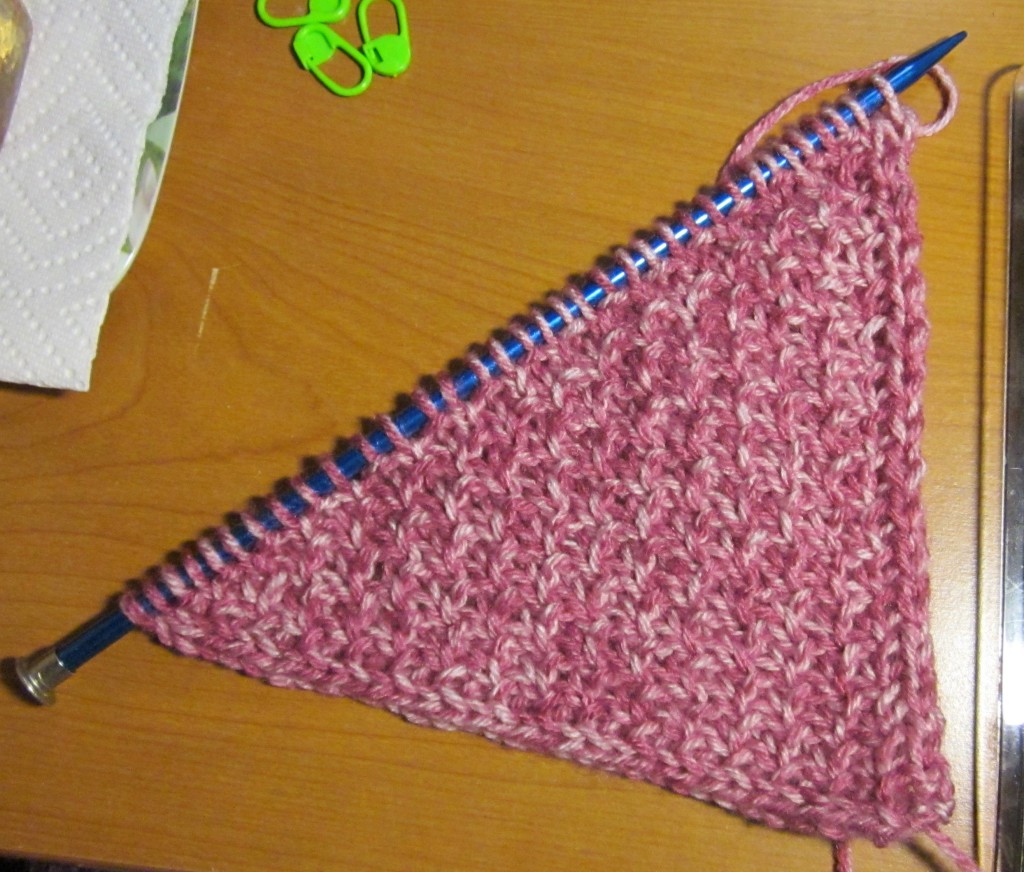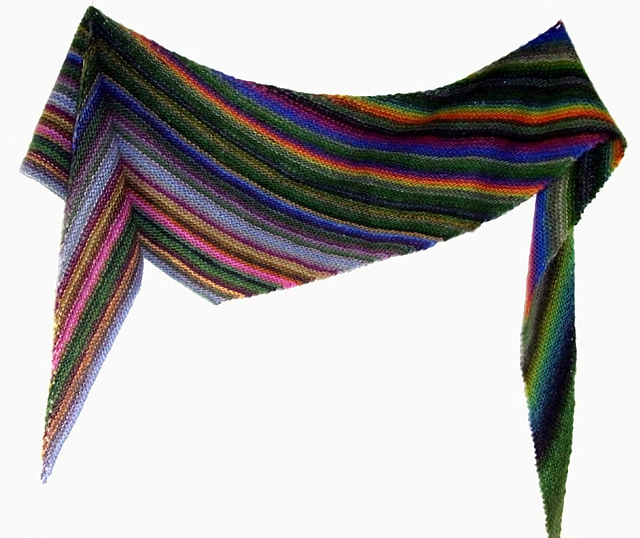
Savannah Squares Scarf Shawl
This is a knit-in-the-round scarf/shawl intended to be worn folded in half diagonally. It can be worn either draped bib style around the neck, or draped around the shoulders in shawl fashion. It can be embellished (as here) with small tassels attached to each corner. It can be knit in any size yarn using any size needles depending on the weight/loft of fabric you want and how you intend to wear it. (A great stash buster project!) This pattern would also make a great baby afghan.
Materials:
Yarn:

Version A: 5 skeins of Red Heart Boutique Unforgettable, Medium (4), 3.5 oz/100g, 270 yds/246 m, color Dragonfly.

Version B: 3 skeins of Malabrigo Sock, Light Fingering (1), 3.53 oz/100 g, 440 yds/402 mm color, Whale’s Road.
Needles: Version A: double pointed needles (DPN) size US 8 (5.0 mm), and circular needles in size US 8 (5.0 mm) of 16 inches, 24 inches, 36 inches and 47 inches in length.
Version B: double pointed needles (DPN) size US 3 (3.25 mm), and circular needles in size US 3 (3.25 mm) of 16 inches, 24 inches, 36 inches and 47 inches in length.
Notions: 4 stitch markers, making sure one is obviously different from the others either in type or color to serve as row marker.
Setup:
Cast on 8 stitches onto a single DPN using long tail cast on method. You will work these stitches off two at a time onto the remaining DPNs until all four DPNs have been brought into play.

Row 1: Kfb, kfb; on the next needle, kfb, kfb; on the next needle, kfb, kfb; on the next needle, kfb, kfb. You should now have four DPNs in play with 4 stitches on each needle (16 sts total). Attach a row marker to the work. Join work to knit in round, being careful not to twist any stitches.
Row 2: Knit in round, *k1, p1, repeat from * to end of row. (16 sts, 4 per DPN)
Row 3: *Kfb, k2, kfb, repeat from * to end of row. (24 sts, 6 per DPN)
Row 4: *k1, p1, repeat from * to end of row. (24 sts, 6 per DPN)
NOTE: Increases are worked on the odd numbered (knit) row; your total number of stitches will increase by 8 stitches at the end of each odd number (knit) row. (6 sts per needle = 24, 8 sts per needle = 32, 10 sts per needle = 40, 12 sts per needle = 48, etc.)
Row 5: *(kfb, k until 1 st remains on needle, kfb), repeat from * x 3 .
Row 6: *k1, p1) repeat from * to end of row
Repeat rows 5 and 6 until the double pointed needles become overcrowded with stitches. Knit off onto the 16-inch circular needle. Each time you knit all the stitches off a DPN, place a marker, placing the row marker after you’ve knitted all the stitches off the fourth DPN. (Again, make sure your row marker is obviously different in either type or color from the other three markers.)
Row 7: *(kfb, k until 1 stitch before marker, kfb), repeat from * to end of row.
Row 8: *(k1, p1), repeat from * to end of row.
Repeat rows 7 and 8 until the scarf measures at least 26 inches from the center point to the tip of a corner. This gives a square with a 52 inch diagonal.
You can end the piece by working a simple bind off, or adding one of the following knitted-on edgings, either in the same yarn or a contrasting color of yarn.

Edging:
Note: In both versions of the edging, the k2tog is always worked using 1 stitch from the body of the scarf and 1 stitch of the edging.
Narrow Edging:
At the end of a row (doesn’t matter which), cast on 3 stitches using the E-loop method.
1. Sl1 wyif, k1, k2tog, turn work.
2. k2tog, sl1 wyif k1, turn work.
Repeat rows 1 and 2 until there are no more stitches left. Bind off and sew edging together.
Wider Edging:
At the end of an even numbered (k1, p1) row, make 6 stitches using the e-loop cast on. Turn work.
Row 1: *sl1 wyif, k6. Turn work.
Row 2: *k2tog, yo, ssk, p1, sl1 wyif, k1. Turn work.
Repeat rows 1 and 2 until 1 stitch before the stitch marker.
To turn the corner at the stitch marker, work:
Row 3: *sl1 wyif, k6. Turn work.
Row 4: *k2tog, yo, ssk, p1, sl1 wyif, k1. Turn work.
Row 5: *sl1 wyif, k5. Turn work, remove stitch marker.
Row 6: *k1, yo, ssk, p1, sl1 wyif, k1. Turn work.
Row 7: *sl1 wyif, k6. Turn work.
Row 8: *k2tog, yo, ssk, p1, sl1 wyif, k1. Turn work.
Repeat from row 1 three more times. Join edging
Abbreviations:
Kfb – knit front and back.
K2togfb – knit two stitches together front and back
Ssk – slip 2 stitches purlwise, knit them together through the back loop.
Sl1p wyif – slip 1 stitch purlwise with yarn in front.























